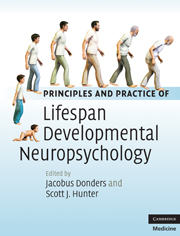Book contents
- Frontmatter
- Contents
- Contact information for authors
- Biography for Jacobus Donders and Scott J. Hunter
- Introduction
- Section I Theory and models
- Section II Disorders
- 5a Attention deficit hyperactivity disorder in children and adolescents
- 5b Attention deficit hyperactivity disorder in adults
- 5c Attention deficit hyperactivity disorder: a lifespan synthesis
- 6a Learning disorders in children and adolescents
- 6b Learning disorders in adults
- 6c Synthesis of chapters on learning disabilities: overview and additional perspectives
- 7a Infants and children with spina bifida
- 7b Adolescence and emerging adulthood in individuals with spina bifida: a developmental neuropsychological perspective
- 7c Spina bifida/myelomeningocele and hydrocephalus across the lifespan: a developmental synthesis
- 8 Cerebral palsy across the lifespan
- 9a Intellectual disability across the lifespan
- 9b Lifespan aspects of PDD/autism spectrum disorders (ASD)
- 9c Autism spectrum disorders and intellectual disability: common themes and points of divergence
- 10a Hearing loss across the lifespan: neuropsychological perspectives
- 10b Visual impairment across the lifespan: neuropsychological perspectives
- 11a Traumatic brain injury in childhood
- 11b Adult outcomes of pediatric traumatic brain injury
- 11c Neurobehavioral aspects of traumatic brain injury sustained in adulthood
- 11d Traumatic brain injury in older adults
- 11e Traumatic brain injury across the lifespan: a long-term developmental perspective
- 12a Pediatric aspects of epilepsy
- 12b A lifespan perspective of cognition in epilepsy
- 13a Leukemia and lymphoma across the lifespan
- 13b Lifespan aspects of brain tumors
- 14 Lifespan aspects of endocrine disorders
- 15 Metabolic and neurodegenerative disorders across the lifespan
- 16a Psychopathological conditions in children and adolescents
- 16b Psychopathological conditions in adults
- 16c Neuropsychological aspects of psychopathology across the lifespan: a synthesis
- Index
- Plate section
- References
13b - Lifespan aspects of brain tumors
from Section II - Disorders
Published online by Cambridge University Press: 07 May 2010
- Frontmatter
- Contents
- Contact information for authors
- Biography for Jacobus Donders and Scott J. Hunter
- Introduction
- Section I Theory and models
- Section II Disorders
- 5a Attention deficit hyperactivity disorder in children and adolescents
- 5b Attention deficit hyperactivity disorder in adults
- 5c Attention deficit hyperactivity disorder: a lifespan synthesis
- 6a Learning disorders in children and adolescents
- 6b Learning disorders in adults
- 6c Synthesis of chapters on learning disabilities: overview and additional perspectives
- 7a Infants and children with spina bifida
- 7b Adolescence and emerging adulthood in individuals with spina bifida: a developmental neuropsychological perspective
- 7c Spina bifida/myelomeningocele and hydrocephalus across the lifespan: a developmental synthesis
- 8 Cerebral palsy across the lifespan
- 9a Intellectual disability across the lifespan
- 9b Lifespan aspects of PDD/autism spectrum disorders (ASD)
- 9c Autism spectrum disorders and intellectual disability: common themes and points of divergence
- 10a Hearing loss across the lifespan: neuropsychological perspectives
- 10b Visual impairment across the lifespan: neuropsychological perspectives
- 11a Traumatic brain injury in childhood
- 11b Adult outcomes of pediatric traumatic brain injury
- 11c Neurobehavioral aspects of traumatic brain injury sustained in adulthood
- 11d Traumatic brain injury in older adults
- 11e Traumatic brain injury across the lifespan: a long-term developmental perspective
- 12a Pediatric aspects of epilepsy
- 12b A lifespan perspective of cognition in epilepsy
- 13a Leukemia and lymphoma across the lifespan
- 13b Lifespan aspects of brain tumors
- 14 Lifespan aspects of endocrine disorders
- 15 Metabolic and neurodegenerative disorders across the lifespan
- 16a Psychopathological conditions in children and adolescents
- 16b Psychopathological conditions in adults
- 16c Neuropsychological aspects of psychopathology across the lifespan: a synthesis
- Index
- Plate section
- References
Summary
Introduction
This chapter will focus on brain tumors across the lifespan with an emphasis on the contribution of developmental factors to incidence, presentation, treatment, and outcome. The epidemiology, classification, signs and symptoms, and major types of treatment of brain tumors are reviewed for children and adults. Neuropsychological outcomes and management strategies are then described for each of these populations separately.
Epidemiology
It is estimated that over 51,000 new cases of primary brain tumors were diagnosed in the USA in 2007, including over 3700 new cases of childhood primary brain tumors [1]. Brain tumors are the most common solid tumor of childhood and a leading cause of cancer-related death; in adults, they constitute the sixth most common neoplasm [2, 3]. The incidence of different types of tumors varies by age group, histology, and location. Survival rates also vary significantly among age groups [Table 13b.1]. Primary brain tumors develop as a consequence of genetic, molecular, or cytogenetic errors that allow cells to proliferate and turn off mechanisms that regulate cell growth [4]. Investigation into the molecular basis of tumorigenesis is an active area of neuroscience research though identification of specific causes of brain tumors has remained elusive, particularly in the case of childhood tumors. Primary risk factors for brain tumors include certain hereditary syndromes associated with mutations of tumor suppressor genes (neurofibromatosis Type 1 and Type 2, Turcot syndrome, nevoid basal cell carcinoma (Gorlin) syndrome, tuberous sclerosis, and Li-Fraumeni syndrome) and exposure to ionizing radiation.
- Type
- Chapter
- Information
- Publisher: Cambridge University PressPrint publication year: 2010

